#smartphone market analysis
Text
Exploring Size, Trends, and Outlook of the Smartphone Market
In the ever-evolving realm of technology, the smartphone market stands as a dynamic and pivotal player. As we delve into the smartphone market's size, growth, analysis, trends, and outlook, we witness an industry that continues to redefine itself in response to consumer demands and technological advancements.
Smartphone Market Size and Growth
The global smartphone market has experienced remarkable expansion over the years, driven by factors such as increased connectivity, rising disposable incomes, and a growing appetite for digital services. According to the latest statistics, the smartphone market size surpassed 1.5 billion units in 2023, reflecting a 5% year-on-year growth.
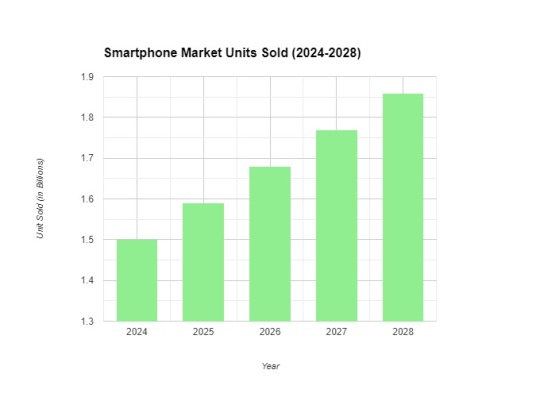
This expansion can be attributed to the relentless innovation in smartphone technology, with manufacturers constantly pushing boundaries to offer consumers devices equipped with cutting-edge features, enhanced performance, and improved user experiences.
Smartphone Market Analysis
A deeper dive into the smartphone industry reveals a nuanced landscape shaped by intense competition and rapid technological advancements. Market analysis indicates that Asia-Pacific remains a dominant force, accounting for over 40% of the global smartphone market share. China, in particular, emerges as a key player, both as a significant consumer and producer in the smartphone industry.
Additionally, the market is witnessing a shift towards mid-range and premium smartphones, as consumers increasingly seek devices that offer a balance between advanced features and affordability. This change is reflected in the market share data, with mid-range smartphones capturing around 35% of the global market, signaling a departure from the previous dominance of budget-friendly options.
Smartphone Market Trends
The smartphone market is marked by several trends that underscore the industry's adaptability to emerging consumer needs. One of the notable trends is the integration of 5G technology into smartphones. With the global rollout of 5G networks, smartphone manufacturers are racing to release 5G-compatible devices, expecting this trend to drive market growth in the coming years.
Another significant trend is the emphasis on sustainability and eco-friendly practices. Consumers are increasingly conscious of the environmental impact of technology, prompting smartphone manufacturers to adopt greener production methods and recyclable materials.
Smartphone Market Outlook
Looking ahead, the smartphone market outlook remains optimistic, fueled by ongoing technological advancements and the continued demand for smarter, more efficient devices. Industry experts project the global smartphone market to witness a CAGR of around 6% from 2024 to 2028, with an anticipated market size exceeding 1.8 billion units by the end of this period.
The outlook is particularly promising for markets in developing regions, where increasing urbanization and a growing middle class contribute to the rising demand for smartphones. However, manufacturers must remain vigilant and adaptable, considering the ever-changing consumer preferences and the potential impact of external factors, such as geopolitical events and economic uncertainties.
Conclusion
In conclusion, the smartphone market is a dynamic and robust industry that constantly reinvents itself to meet the evolving needs of consumers. With a global market size exceeding 1.5 billion units and a projected growth rate of 6%, the outlook is undeniably positive. As the market continues to evolve, key trends such as 5G integration and sustainability will play pivotal roles in shaping the industry's trajectory. The smartphone market stands as a testament to the relentless pursuit of innovation, ensuring that these pocket-sized devices remain indispensable in our increasingly connected world.
#market research#business#ken research#market analysis#market report#market research report#smartphone market#smartphone industry#global smartphone market#worldwide smartphone market share#smartphone market share#global smartphone market share#world smartphone market share#smartphone market outlook#global smartphone industry#global smartphone market growth#smartphone market analysis#smartphone market revenue#smartphone market trends#smartphone market size#smartphone sector
1 note
·
View note
Text
Smartphone-Connected Pacemaker Devices Market Current Analysis & Forecast by 2027
The global Smartphone-Connected Pacemaker Devices Market is projected to experience substantial growth by 2027, with a notable Compound Annual Growth Rate (CAGR) during the forecast period from 2021 to 2027. The increasing prevalence of heart failure and arrhythmia has driven the demand for advanced, smartphone-connected cardiac devices, known as pacemakers. These devices can track data and monitor patient health through wireless remote systems, indicating a significant market expansion in the coming years.

Several factors are driving this market, including the rising incidence of cardiovascular diseases and the increasing demand for connected medical devices. Growing consumer awareness and higher disposable incomes have also contributed to the market's growth. Moreover, advancements in pacemaker technology, such as multi-functional capabilities, are expected to further propel the market. Modern smart pacemakers utilize real-time EGM waveforms for monitoring and can be programmed to automatically record and store data when specific triggers are encountered. According to DiCardiology, approximately 3 million people worldwide had pacemakers in 2018, with around 600,000 new pacemakers implanted annually to treat bradycardia. The rising incidence of cardiovascular diseases, such as heart failure and stroke, is anticipated to boost the demand for smartphone-connected pacemakers.
For a comprehensive analysis of the market drivers, visit: https://univdatos.com/report/smartphone-connected-pacemaker-devices-market
The COVID-19 pandemic significantly impacted the market, leading to a decline in demand due to lockdowns, trade suspensions, and the rescheduling of routine hospital operations. For example, the Journal of Arrhythmia reported a 73% reduction in pacemaker implants during the pandemic, along with a 78% decline in cardiovascular diagnoses and new pacemaker implants. However, the market has regained traction following the relaxation of COVID-19 restrictions.
The market is segmented by product type, with implantable and external pacemakers. In 2020, implantable pacemakers dominated the market due to their effectiveness in controlling heartbeats and their use in treating slow heart rates after heart attacks, surgeries, or medication overdoses. The market is also divided by type into MRI-compatible and conventional pacemakers. MRI-compatible pacemakers accounted for a major revenue share in 2020, as patients with heart conditions often require MRI scans to detect serious issues.
Application-wise, the market is segmented into Arrhythmia, Congestive Heart Failure, and others, with the Arrhythmia segment leading in 2020 due to the increasing prevalence of arrhythmia among the aging population. End-user segments include hospitals & cardiac centers, ambulatory surgical centers, and others. Hospitals & cardiac centers are expected to see significant growth due to their superior patient care and compensation offerings during surgeries.
For a sample report, visit: https://univdatos.com/request_form/form/438
The report also provides a detailed regional analysis, covering North America, Europe, Asia-Pacific, and the Rest of the World. North America led the market in 2020, driven by the presence of major companies and advanced healthcare infrastructure in the U.S. Key market players include Medtronic PLC, Boston Scientific Corporation, BIOTRONIK, LivaNova PLC, Abbott Laboratories, MEDICO SpA, Pacetronix, Osypka Medical, Inc., Lepu Medical Group, and Cook Medical. These companies have engaged in mergers, acquisitions, and partnerships to enhance their market presence in the smartphone-connected pacemaker devices sector.
Contact Us:
UnivDatos Market Insights
Email - [email protected]
Contact Number - +1 9782263411
Website -www.univdatos.com
#Smartphone-Connected Pacemaker Devices Market#Smartphone-Connected Pacemaker Devices Market Size#Smartphone-Connected Pacemaker Devices Market Share#Smartphone-Connected Pacemaker Devices Market Analysis
0 notes
Text
0 notes
Text
Ultra-Thin Glass Market Is Estimated To Witness High Growth Owing To Increasing Demand for Lightweight and Flexible Displays

The global Ultra-Thin Glass Market is estimated to be valued at US$ 11.66 billion in 2022 and is expected to exhibit a CAGR of 7.2% over the forecast period 2023-2030, as highlighted in a new report published by Coherent Market Insights.
Market Overview:
Ultra-thin glass is a specialty glass with thickness ranging from 0.1mm to 0.5mm. It is widely used in various industries such as electronics, automotive, and solar panels. The key advantage of ultra-thin glass is its lightweight and flexibility, which makes it suitable for applications such as displays, touchscreens, and solar cells. The growing demand for lightweight and flexible displays in smartphones, tablets, and wearable devices is driving the market growth. Ultra-thin glass offers several advantages over traditional glass, including improved optical properties, durability, and enhanced performance.
Market Key Trends:
One key trend in the ultra-thin glass market is the increasing adoption of foldable smartphones and wearable devices. Foldable smartphones require flexible and durable displays, which can be achieved using ultra-thin glass. Companies like Samsung and Huawei have already launched foldable smartphones with ultra-thin glass displays. This trend is expected to drive the demand for ultra-thin glass in the coming years.
For example, Corning Inc., one of the key players in the ultra-thin glass market, has developed a flexible glass called Willow Glass, which is used in the manufacturing of foldable smartphones and wearable devices. This ultra-thin glass offers superior flexibility and durability, making it suitable for curved displays.
PEST Analysis:
- Political: The political stability of a country can affect the manufacturing and export of ultra-thin glass. Government regulations related to environmental protection and trade policies can also impact the market.
- Economic: The economic growth of a country influences consumer spending on electronic devices, which drives the demand for ultra-thin glass.
- Social: Changing consumer preferences towards lightweight and flexible devices, as well as the increasing adoption of smart devices, are key social factors driving market growth.
- Technological: Advancements in glass manufacturing technologies, such as float glass and fusion draw processes, have enabled the production of ultra-thin glass with enhanced properties.
Key Takeaways:
- The Global Ultra-Thin Glass Market Size is expected to witness high growth, exhibiting a CAGR of 7.2% over the forecast period, due to the increasing demand for lightweight and flexible displays. The growing adoption of foldable smartphones and wearable devices is driving the market growth.
- Asia Pacific is expected to be the fastest-growing and dominating region in the ultra-thin glass market. The region is witnessing significant growth in the electronics industry, especially in countries like China, Japan, and South Korea.
- Key players operating in the global ultra-thin glass market include Corning Inc., AGC Inc., Schott AG, Nippon Electric Glass Co., Ltd., Central Glass Co., Ltd., Xinyi Glass Holdings Limited, AIR-CRAFTGLASS, NOVALGLASS, and Taiwan Glass Group. These companies are focusing on product innovation and partnerships to expand their market presence.
#Ultra-Thin Glass Market#Ultra-Thin Glass Market Outlook#Ultra-Thin Glass Market Forecast#Ultra-Thin Glass Market Analysis#Ultra-Thin Glass Value#Ultra-Thin Glass#display devices#smartphones#tablets#televisions#plastic substrates#Coherent Market Insights
0 notes
Text
The Business Research Company offers smartphone processor market research report 2023 with industry size, share, segments and market growth
#smartphone processor market growth#smartphone processor market analysis#smartphone processor market share#smartphone processor market report#smartphone processor market segments#smartphone processor market size#smartphone processor market research#smartphone processor market forecast#smartphone processor market trends#global smartphone processor market
0 notes
Text
Smartphones Market Industry Share, Size, Growth, Demands, Revenue, Top Leaders and Forecast to 2028
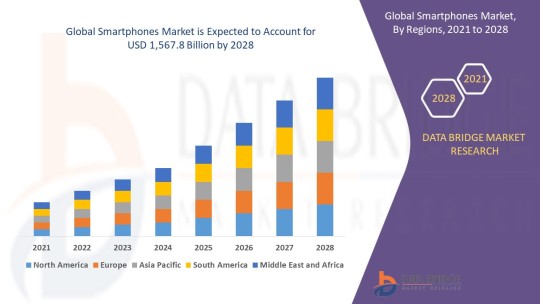
Industry Analysis
Smartphones market will reach at an estimated value of USD 1,567.8 billion grow at a rate of 6.80% for the forecast period of 2021 to 2028. Smartphones market report analyses the growth, which is currently being growing due to rise in the significant penetration of social media and internet services.
Additionally, the credible Smartphones Market report helps the manufacturer in finding out the effectiveness of the existing channels of distribution, advertising programs, or media, selling methods and the best way of distributing the goods to the eventual consumers. Taking up such market research report is all the time beneficial for any company whether it is a small scale or large scale, for marketing of products or services. It makes effortless for FMCG industry to visualize what is already available in the market, what market anticipates, the competitive environment, and what should be done to surpass the competitor.
Get a Free Sample of The Report: https://www.databridgemarketresearch.com/request-a-sample/?dbmr=global-smartphones-market
Market Insights and Scope
Smartphones can be defined as a specific category of mobile phones which have a significantly high level of hardware performance, and software services. They are usually equipped with numerous multimedia alternatives such as music, cameras, gaming solutions as well as including the existing functionality of feature phones such as calling, messaging. These products also include a variety of sensors, and can also support numerous wireless communication services such as Wi-Fi, Bluetooth and satellite navigation.
An international Smartphones Market research report examines competitive companies and manufacturers in the global market. Competitive analysis carried out in this market report puts forth the moves of the key players in the FMCG industry such as new product launches, expansions, agreements, joint ventures, partnerships, and recent acquisitions. This market report puts light on various aspects of marketing research that range from important industry trends, market size, market share estimates, sales volume, emerging trends, product consumption, customer preferences, historic data along with future forecast and key player analysis. It studies market by product type, applications and growth factors.
Get full access to the report: https://www.databridgemarketresearch.com/reports/global-smartphones-market
Industry Segmentation
Smartphones market is segmented on the basis of operating system, distribution channel, price and ram size. The growth amongst the different segments helps you in attaining the knowledge related to the different growth factors expected to be prevalent throughout the market and formulate different strategies to help identify core application areas and the difference in your target markets.
On the basis of operating system, smartphones market is segmented into android, iOS and windows.
Based on distribution channel, the smartphones market is segmented into OEM, retailer and e-commerce.
Based on price, the smartphones market is segmented into high range, medium range and low range.
The smartphones market is also segmented on the basis of ram size into below 2GB, 2GB-4GB and up to 8GB.
Market Country Level Analysis
The countries covered in the smartphones market report are
U.S., Canada and Mexico in North America, Germany, France, U.K., Netherlands, Switzerland, Belgium, Russia, Italy, Spain, Turkey, Rest of Europe in Europe, China, Japan, India, South Korea, Singapore, Malaysia, Australia, Thailand, Indonesia, Philippines, Rest of Asia-Pacific (APAC) in the Asia-Pacific (APAC), Saudi Arabia, U.A.E, Israel, Egypt, South Africa, Rest of Middle East and Africa (MEA) as a part of Middle East and Africa (MEA), Brazil, Argentina and Rest of South America as part of South America.
An influential Smartphones Market research report displays an absolute outline of the market that considers various aspects such as product definition, customary vendor landscape, and market segmentation. Currently, businesses are relying on the diverse segments covered in the market research report to a great extent which gives them better insights to drive the business on the right track. The competitive analysis brings into light a clear insight about the market share analysis and actions of the key industry players. With this info, businesses can successfully make decisions about business strategies to accomplish maximum return on investment (ROI).
Industry Share Analysis
The major players covered in the smartphones market report are
SAMSUNG; Apple Inc.; Lenovo; Huawei Technologies Co., Ltd.; Sony Corporation; Xiaomi; LG Electronics; ZTE Corporation; TCL COMMUNICATION TECHNOLOGY HOLDINGS LIMITED; Vivo Communication Technology Co. Ltd.; Nokia; OPPO; HTC Corporation; OnePlus and Mobitech Creations; Google; Reliance Retail Ltd.; ASUSTeK Computer Inc.; XOLO; Micromax and Koninklijke Philips N.V among other domestic and global players. Market share data is available for global, North America, Europe, Asia-Pacific (APAC), Middle East and Africa (MEA) and South America separately.
Browse Related Reports@
Global Frozen Vegetables Market
South Africa Battery Market
Global Plant-Based Egg Market
Global Nutritional Beverages market
Spain Fuel Cards Market for Commercial Fleet
Europe Fall Detection System Market
About Us:Data Bridge Market Research set forth itself as an unconventional and neoteric Market research and consulting firm with an unparalleled level of resilience and integrated approaches. We are determined to unearth the best market opportunities and foster efficient information for your business to thrive in the market
Contact:
Data Bridge Market Research
Tel: +1-888-387-2818
Email: [email protected]
#Smartphones Market Growing Popularity and Traffic#Smartphones Market Global Leading Brands and Businesses#Smartphones Market drivers-advantages-restraints and challenges#Smartphones Market Value-Segmentation-CAGR rate-Future Trends#Smartphones Market Demands-Size-Share-Top Trends#Smartphones Market Industry Insights-Country-Competitors#Smartphones Market Growth-Competition-Scenario-Outlook#Smartphones Market Global Opportunity Analysis#Smartphones Market 2028 by Product-Types-Procedure#Smartphones Market FMCG Industry
0 notes
Text
Smartphone Docks Market Growth, Overview with Detailed Analysis 2022-2028
Smartphone Docks Market Growth, Overview with Detailed Analysis 2022-2028
The Smartphone Docks Market research report 2022-2030 provides an in-depth analysis of the changing trends, opportunities, and challenges influencing the growth over the next decade. The study includes a detailed summary of each market along with data related to demand, supply and distribution. The report examines Smartphone Docks market growth strategies adopted by leading manufacturers which…
View On WordPress
#Covid-19 Impact Analysis#Smartphone Docks#Smartphone Docks forecast#Smartphone Docks Industry#Smartphone Docks Market#Smartphone Docks price#Smartphone Docks report#Smartphone Docks research#Smartphone Docks share#Smartphone Docks trends
0 notes
Text
#Smartphone Power Management Ic Market Size#Industry Analysis By Segmentations#Top Key Players#Trends#Future Development & Forecast
0 notes
Text
The White Smartwatch: A Blend of Style and Innovation for Your Wrist

In today’s fast-paced world, smartwatches have become an essential accessory for those who seek a perfect balance of fashion, technology, and functionality. One of the standout options in the market is the White Smartwatch, which not only offers cutting-edge features but also enhances your everyday look with its sleek and modern design. At Alltrade.ae, we bring you an impressive range of white smartwatches that complement any lifestyle, whether you're tracking fitness, managing daily tasks, or staying connected on the go.
1. Elegance Meets Functionality
A white smartwatch exudes elegance, making it a perfect accessory for any occasion, whether you're dressing up for a business meeting or keeping it casual. The neutral white color is versatile, blending effortlessly with any outfit while adding a touch of sophistication. But don’t be fooled by its stylish appearance—these watches are packed with powerful features that keep you connected and on track throughout the day.
2. Fitness at Your Fingertips
One of the main reasons people opt for smartwatches is their ability to track health and fitness metrics. The white smartwatch is equipped with a host of health-monitoring tools, including heart rate tracking, step counting, sleep analysis, and even workout modes for various exercises. Whether you’re a fitness enthusiast or just starting your health journey, the smartwatch provides valuable insights into your daily activity levels, helping you stay motivated and reach your goals.
3. Stay Connected, Anytime, Anywhere
Gone are the days when you needed to pull out your phone for every notification. With the white smartwatch from Alltrade.ae, you can receive calls, texts, social media alerts, and even control music playback right from your wrist. Its seamless connectivity to your smartphone ensures you never miss an important update, even when you're on the move.
4. Long-Lasting Battery Life
Worried about constantly charging your devices? The white smartwatch is designed with long-lasting battery life, ensuring it keeps up with your busy schedule. Whether you're using it for fitness tracking, GPS navigation, or simply checking the time, this smartwatch can go for days on a single charge, making it a reliable companion.
5. Advanced Features at Your Disposal
In addition to its basic functions, the white smartwatch offers advanced features like GPS tracking, voice assistant compatibility, and even water resistance for those who lead an active lifestyle. Its touch-screen interface is intuitive and user-friendly, making it easy to navigate through apps and settings. Some models also offer customizable watch faces, allowing you to personalize the display to suit your taste.
6. A Gift Worth Giving
Looking for the perfect gift for a tech-savvy friend or loved one? The white smartwatch is a thoughtful present that combines practicality with luxury. Whether it's for a birthday, holiday, or special occasion, this stylish accessory will impress anyone who receives it. Plus, with the variety of models available on Alltrade.ae, you’re sure to find the perfect match for their needs.
7. Why Choose Alltrade.ae for Your White Smartwatch?
At Alltrade.ae, we understand the importance of combining quality with affordability. Our collection of white smartwatches is carefully selected to ensure you get the best of both worlds. We offer an extensive range of options with varying features, ensuring there’s something for everyone. Plus, our hassle-free online shopping experience allows you to explore, compare, and purchase with ease.
Conclusion
The white smartwatch is more than just a timepiece—it’s a lifestyle upgrade that offers convenience, style, and functionality in one sleek package. Whether you're looking to stay on top of your fitness goals, manage your day efficiently, or simply accessorize with elegance, a white smartwatch from Alltrade.ae is the ideal choice.
Explore our collection today and find the perfect white smartwatch that fits your style and needs!
#beauty#home & lifestyle#ecommerce#onlineshopping#retail#fashion#sales#dubai#uae#automotive#alltrade
2 notes
·
View notes
Text
Smartphone Market Trends, Analysis, and Outlook
Introduction:
The smartphone market is a dynamic and ever-evolving industry that plays a pivotal role in shaping the global technological landscape. As of the latest available data in 2023, the smartphone market size reached an impressive $522 billion, reflecting a steady growth trajectory. In this article, we will delve into the key trends, analysis, and outlook for the smartphone market, exploring the market share, growth, and revenue that define the industry.
Smartphone Market Size and Share:
The smartphone market has witnessed robust expansion, with the global market size surging to new heights. According to the latest statistics, the smartphone market is anticipated to exceed 1.5 billion units in sales by the end of 2023. This surge is fueled by the increasing demand for advanced features, enhanced connectivity, and the integration of cutting-edge technologies.
In terms of market share, industry leaders continue to dominate, with companies like Apple, Samsung, and Huawei maintaining a significant presence. As of the latest available data, Apple held a remarkable 23% of the global market share, closely followed by Samsung with 20%, showcasing the fierce competition among top players.

Smartphone Market Growth and Revenue:
The growth of smartphone market is not only reflected in the increasing unit sales but also in the revenue generated by industry players. The global smartphone market revenue witnessed a 9% year-on-year growth, reaching an unprecedented $522 billion in 2023. This growth can be attributed to factors such as the introduction of 5G technology, rising consumer disposable income, and a continuous influx of innovative features and designs.
The integration of 5G technology has been a game-changer, driving higher demand for smartphones with enhanced connectivity and faster data speeds. This technological shift has not only fueled market growth but has also opened new opportunities for manufacturers and service providers to capitalize on the evolving needs of consumers.
Smartphone Market Trends:
Several trends are shaping the smartphone market, influencing consumer preferences and industry dynamics. One notable trend is the increasing focus on sustainability and eco-friendly practices. Consumers are becoming more conscious of the environmental impact of electronic devices, prompting smartphone manufacturers to adopt eco-friendly materials, reduce packaging waste, and implement recycling programs.
Another prominent trend is the continuous evolution of camera technology. Smartphone manufacturers are investing heavily in improving camera capabilities, including advanced sensors, artificial intelligence (AI) enhancements, and innovative shooting modes. The emphasis on camera technology reflects the growing importance of photography and videography in the smartphone user experience.

Smartphone Market Analysis:
A comprehensive analysis of the smartphone market reveals the importance of adapting to changing consumer behaviors and technological advancements. The rise of affordable and feature-rich smartphones in emerging markets is a significant factor driving global sales. Additionally, the shift towards online sales channels, coupled with aggressive marketing strategies, is reshaping the retail landscape for smartphones.
The increasing prevalence of subscription-based models and finance options is another aspect of the market analysis. Smartphone manufacturers are providing consumers with flexible payment plans and trade-in programs, making high-end devices more accessible and affordable.
Smartphone Industry Top Players:
The competition among top players in the smartphone industry remains intense. Apple, known for its premium devices and ecosystem, continues to capture a substantial market share. Samsung, a key player with a diverse product portfolio, remains a strong contender. Huawei, despite facing challenges, maintains a significant presence, especially in the Asian market.
Other notable players in the smartphone industry include Xiaomi, Oppo, and Vivo, which have gained popularity for offering feature-rich devices at competitive price points. The industry's dynamism is characterized by continuous innovation, strategic partnerships, and a focus on meeting the diverse needs of global consumers.
Smartphone Market Outlook:
Looking ahead, the smartphone market is poised for continued growth and innovation. The deployment of 6G technology is on the horizon, promising even faster data speeds and more advanced connectivity. Furthermore, the integration of augmented reality (AR) and virtual reality (VR) features is expected to redefine the smartphone user experience.
As the smartphone market evolves, manufacturers must stay attuned to consumer preferences, environmental concerns, and technological advancements. The industry's ability to navigate these dynamics will determine its resilience and competitiveness in the years to come.
Conclusion:
In conclusion, the smartphone industry is a dynamic and thriving industry, with a global market size surpassing $522 billion in 2023. The interplay of market share, growth, revenue, trends, analysis, and the top players underscores the complexity and competitiveness of the sector. As the industry continues to evolve, it is crucial for stakeholders to adapt to emerging trends, leverage innovative technologies, and prioritize sustainability to ensure sustained success in this ever-changing landscape.
#market research#business#ken research#market analysis#market report#market research report#smartphone market forecast#smartphone market growth#smartphone market revenue#smartphone market share#smartphone market size#smartphone market trends
1 note
·
View note
Text
Top Mobile Advertising Agency in Gurgaon, India

Gurgaon, now officially known as Gurgaon, has rapidly transformed into a bustling hub for businesses, technology, and innovation. As companies vie for consumer attention in this dynamic market, mobile advertising has emerged as a powerful tool to reach target audiences effectively. To capitalize on this opportunity, businesses must partner with the Best Mobile Advertising Company in Gurgaon. In this blog post, we explore the key attributes that define Gurgaon's top mobile advertising agencies and spotlight ARSHIYA InfoSolutions, a leader in this space.
The Mobile Advertising Landscape in Gurgaon
Mobile advertising refers to the practice of reaching consumers through mobile devices like smartphones and tablets. Given the exponential growth of mobile internet users in India, particularly in urban centers like Gurgaon, mobile advertising has become indispensable for businesses aiming to maximize their reach and engagement.
Mobile advertising encompasses various formats, including in-app ads, mobile web ads, SMS and MMS campaigns, and mobile video ads. Each format has unique advantages and requires specialized expertise to execute effectively. The Best Mobile Advertising Company in Gurgaon must be proficient across these formats and adept at leveraging data and technology to optimize campaigns.
Key Attributes of the Best Mobile Advertising Company in Gurgaon
1. Comprehensive Service Offering
A top mobile advertising agency should provide a full spectrum of services, from strategy development to campaign execution and performance analysis. ARSHIYA InfoSolutions excels in delivering end-to-end mobile advertising solutions, ensuring that every aspect of your campaign is meticulously managed for optimal results. Their holistic approach enables businesses to achieve cohesive and impactful advertising efforts.
2. Expertise and Experience
Experience is a critical factor in mobile advertising. Agencies with a proven track record bring invaluable insights and a deep understanding of consumer behavior. ARSHIYA InfoSolutions boasts years of experience in the industry, with a portfolio that includes successful campaigns across diverse sectors. Their expertise ensures that they can navigate the complexities of the Gurgaon market and deliver effective advertising solutions.
3. Technological Innovation
The mobile advertising landscape is continually evolving, driven by advancements in technology. The Best Mobile Advertising Company in Gurgaon should be at the forefront of these changes, utilizing the latest tools and technologies to enhance campaign performance. ARSHIYA InfoSolutions leverages cutting-edge technologies such as artificial intelligence (AI) and machine learning (ML) to optimize ad placements, personalize content, and improve ROI.
4. Data-Driven Approach
Effective mobile advertising relies heavily on data analytics. An agency’s ability to analyze and interpret data can significantly impact the success of a campaign. ARSHIYA InfoSolutions employs sophisticated data analytics to gain insights into user behavior, preferences, and trends. This data-driven approach allows them to create highly targeted and personalized ad campaigns that resonate with the audience.
5. Creative Excellence
Creativity is a cornerstone of successful mobile advertising. Engaging and visually appealing ads capture attention and drive higher engagement. ARSHIYA InfoSolutions’ team of creative professionals excels in crafting compelling ad creatives that stand out in the crowded digital space. Their creativity, combined with strategic planning, ensures that campaigns are both visually striking and effective.
6. Transparency and Reporting
Transparency in campaign performance and reporting is crucial for building trust and making informed decisions. The Best Mobile Advertising Company in Gurgaon should provide clear and detailed reports on key performance metrics. ARSHIYA InfoSolutions is committed to transparency, offering clients comprehensive reporting and analytics that highlight campaign performance, insights, and areas for improvement.
7. Client-Centric Approach
An agency’s ability to understand and cater to the unique needs of its clients sets it apart. ARSHIYA InfoSolutions takes a client-centric approach, prioritizing communication, collaboration, and responsiveness. Their dedication to client satisfaction ensures that campaigns are tailored to meet specific business objectives and deliver measurable results.
Why ARSHIYA InfoSolutions is the Best Choice for Mobile Advertising in Gurgaon
ARSHIYA InfoSolutions stands out as the Best Mobile Advertising Company in Gurgaon for several compelling reasons.
Comprehensive Services: ARSHIYA InfoSolutions offers a wide range of services, from strategy development to execution and analysis, ensuring seamless campaign management.
Experience and Expertise: With years of industry experience, ARSHIYA InfoSolutions has a proven track record of delivering successful campaigns across various sectors.
Technological Innovation: ARSHIYA InfoSolutions utilizes the latest technologies, including AI and ML, to optimize campaigns and enhance performance.
Data-Driven Insights: Their data analytics capabilities enable highly targeted and personalized advertising efforts.
Creative Excellence: ARSHIYA InfoSolutions’ creative team produces visually appealing and engaging ad creatives that capture attention and drive results.
Transparency: Comprehensive reporting and analytics provide clear insights into campaign performance.
Client-Centric Approach: ARSHIYA InfoSolutions’ dedication to understanding and meeting client needs ensures tailored solutions and exceptional service.
Conclusion
In the competitive landscape of Gurgaon, mobile advertising is a critical component of a successful marketing strategy. Partnering with the Best Mobile Advertising Company in Gurgaon can significantly enhance your brand’s reach and engagement. ARSHIYA InfoSolutions, with its comprehensive service offering, technological innovation, and client-centric approach, is the ideal partner for businesses looking to leverage mobile advertising to its fullest potential. By choosing ARSHIYA InfoSolutions, you can be assured of impactful, data-driven, and creative advertising solutions that drive tangible results in the dynamic market of Gurgaon.
Whether you are a start-up aiming to build brand awareness or an established business seeking to optimize your advertising efforts, ARSHIYA InfoSolutions has the expertise and experience to help you achieve your goals. As the best mobile advertising company in Gurgaon, ARSHIYA InfoSolutions is committed to delivering excellence and innovation, ensuring that your mobile advertising campaigns are successful and transformative.
3 notes
·
View notes
Text
Predicting Upcoming Trends in NLP and Content Marketing: What Businesses Need to Know
In the fast-evolving landscape of digital marketing, Natural Language Processing (NLP) is emerging as a game-changer. NLP, a branch of artificial intelligence, enables machines to understand, interpret, and respond to human language in a valuable way. With its integration into content marketing, the future of NLP in content marketing looks incredibly promising. Let’s dive into the upcoming NLP trends and their potential impacts on businesses and marketers. Plus, I’ll share strategies to help you stay ahead of these advancements.
Understanding NLP and Its Importance for content marketing
What is NLP?
Natural Language Processing (NLP) is the intersection of linguistics, computer science, and artificial intelligence. It focuses on enabling machines to comprehend and process human language. Think of it as the technology behind your favourite voice assistant or the predictive text in your smartphone.
Why NLP Matters in Content Marketing
Content marketing is all about delivering the right message to the right audience. With NLP, marketers can better understand user intent, personalise content, and enhance user engagement. By leveraging NLP, businesses can craft content that resonates more profoundly with their audience.
Upcoming NLP Trends in Content Marketing
1. Enhanced Sentiment Analysis
Sentiment analysis is no longer about simply identifying positive or negative sentiments. The future of NLP in content marketing will involve more nuanced sentiment analysis, understanding complex emotions like sarcasm, irony, and mixed feelings. This will help brands gauge customer sentiment more accurately and tailor their strategies accordingly.
2. Advanced Personalisation for content marketing
Personalisation will reach new heights with NLP. Imagine a world where content is not just personalised by demographic data but also by real-time behavioural data. NLP will enable marketers to create hyper-personalised content marketing, enhancing user experience and driving higher engagement rates.
3. Improved Chatbots and Virtual Assistants
Chatbots and virtual assistants will become even more sophisticated. They’ll understand context better, offer more relevant responses, and engage users in more natural conversations. This advancement will revolutionise customer service and engagement in content marketing.
4. Content marketing and generation
NLP-powered content generation tools will become mainstream. These tools will assist marketers in creating high-quality content marketing quickly and efficiently, from blog posts to social media updates. They’ll understand the tone, style, and context needed, ensuring consistency in brand messaging.
5. Voice Search Optimisation
As voice search continues to rise, NLP will play a crucial role in optimising content for voice queries. Marketers will need to focus on creating conversational content marketing that aligns with how people speak rather than type.
6. Multilingual Capabilities
Breaking language barriers will be easier than ever. NLP will facilitate the creation of multilingual content, allowing brands to reach a global audience effortlessly. This trend will be pivotal for businesses aiming to expand their international presence.
Potential Impacts on Businesses and Marketers
Transforming Customer Interactions
NLP will transform how businesses interact with their customers. With advanced chatbots and virtual assistants, companies can provide instant support and personalised recommendations, enhancing customer satisfaction and loyalty.
Data-Driven Insights
NLP will offer deeper insights into customer behaviour and preferences. By analysing large volumes of data, businesses can make more informed decisions and refine their marketing strategies to meet customer needs better.
Boosting SEO Efforts for content marketing
NLP will significantly impact SEO strategies. Search engines are becoming smarter at understanding user intent, and NLP will help marketers optimise their content to align with these evolving algorithms. This means higher search rankings and increased organic traffic.
Enhancing Content Marketing Quality
With NLP, content quality will improve dramatically. Automated content generation tools will assist in creating well-structured, engaging, and error-free content. This will save time and resources while maintaining a high standard of content output.
Strategies to Stay Ahead in NLP Advancements
1. Invest in NLP Technology
Investing in the right NLP tools and technologies is crucial. Whether it’s for sentiment analysis, content generation, or chatbots, having the right tools will give you a competitive edge.
2. Focus on Data
Data is the backbone of NLP. Ensure you have a robust data collection and analysis strategy in place. This will help you understand your audience better and create more targeted and effective content.
3. Keep Up with Trends
The world of NLP is continuously evolving. Stay updated with the latest upcoming NLP trends and advancements by following industry blogs, attending conferences, and participating in webinars.
4. Leverage Expert Help
Consider working with experts in NLP and content marketing. Agencies like AI SEO Services offer comprehensive services that can help you navigate the complexities of NLP and maximise its benefits for your business.
5. Train Your Team
Ensure your marketing team is well-versed in NLP technologies and their applications. Provide training and resources to help them stay updated and proficient in using these tools effectively.
6. Optimise for Voice Search
With the rise of voice search, optimising your content for voice queries is essential. Focus on creating conversational content and using long-tail keywords that match natural speech patterns.
7. Prioritise User Experience in Content Marketing
At the end of the day, user experience is paramount. Use NLP to enhance the overall user experience on your website and other digital platforms. Personalised, relevant, and engaging content will keep users coming back.
8. Monitor and Adapt
Regularly monitor the performance of your NLP strategies and be ready to adapt as needed. The digital landscape is dynamic, and staying flexible will help you stay ahead of the future of NLP in content marketing.
Conclusion
NLP is set to revolutionise content marketing, offering unprecedented opportunities for businesses and marketers. By staying informed about upcoming trends and proactively adopting NLP technologies, you can ensure your marketing strategies remain effective and competitive. Remember, the key to success lies in understanding your audience, delivering personalised content, and continuously adapting to the ever-changing digital landscape.
Speaking of staying ahead, AI SEO Services is a leading agency that can help you leverage NLP and other cutting-edge technologies for your content marketing needs. Our services include everything from web design to copywriting, SEO, and voice search optimisation. Check out our testimonials to see how we’ve helped other businesses succeed.Incorporating the upcoming NLP trends and staying ahead in the content marketing game is easier with the right partner. For comprehensive and expert guidance, consider AI SEO Services agency services around this keyword: AI SEO Services. Our team is dedicated to helping you harness the power of AI and NLP to drive your business forward. From AI-driven SEO to content marketing, we’ve got you covered.

2 notes
·
View notes
Text
Unleashing the Power of Ecommerce Development Services

In the digital era, ecommerce has revolutionized the way businesses sell products and services, offering unparalleled opportunities for growth and expansion. A robust ecommerce website not only enhances customer reach but also boosts sales and improves brand visibility. Wartiz Technologies, a leader in ecommerce development services, leverages cutting-edge technologies and industry expertise to empower businesses with powerful ecommerce solutions. Let's explore how Wartiz Technologies unleashes the power of ecommerce development.
**1. ** Customized Ecommerce Solutions:
Wartiz Technologies begins by understanding the unique needs and goals of each client. They offer customized ecommerce development services tailored to specific business requirements, whether it's building a new online store from scratch or enhancing an existing ecommerce platform. By integrating advanced features and functionalities, they create scalable and flexible solutions that drive business growth.
**2. ** Responsive and User-Friendly Design:
With a focus on delivering exceptional user experiences, Wartiz Technologies prioritizes responsive design for ecommerce websites. They ensure seamless navigation and optimal performance across devices, including desktops, tablets, and smartphones. A user-friendly interface coupled with intuitive design elements enhances usability and encourages conversions, maximizing the effectiveness of ecommerce platforms.
**3. ** Ecommerce Platform Integration:
Wartiz Technologies integrates leading ecommerce platforms such as Shopify, WooCommerce, Magento, or develops custom solutions based on client preferences. They provide expertise in setting up product catalogs, managing inventory, processing payments securely, and optimizing checkout processes. Seamless integration of third-party plugins and APIs further enhances functionality and enhances the overall ecommerce experience.
**4. ** Search Engine Optimization (SEO) and Digital Marketing:
To increase online visibility and attract organic traffic, Wartiz Technologies incorporates SEO best practices into ecommerce development. They optimize product pages, implement strategic keyword targeting, and ensure fast page load times to improve search engine rankings. Additionally, they offer digital marketing services including PPC campaigns, social media marketing, and content strategy to drive targeted traffic and maximize ROI.
**5. ** Security and Payment Gateway Integration:
Ensuring the security of customer transactions is paramount in ecommerce. Wartiz Technologies implements robust security measures and integrates reliable payment gateways to safeguard sensitive information. They comply with industry standards such as PCI DSS to protect against fraud and provide customers with a secure and trustworthy shopping experience.
**6. ** Analytics and Performance Monitoring:
Continuous monitoring and analysis of ecommerce performance are essential for optimizing business outcomes. Wartiz Technologies sets up analytics tools to track key metrics such as sales performance, visitor behavior, and conversion rates. They provide actionable insights that enable businesses to make informed decisions and refine their ecommerce strategies for greater success.
**7. ** Support and Maintenance:
Beyond development, Wartiz Technologies offers ongoing support and maintenance services to ensure the smooth operation of ecommerce websites. They conduct regular updates, perform backups, and provide technical assistance to resolve issues promptly. Proactive maintenance helps prevent downtime and ensures uninterrupted online sales and customer support.
Conclusion
Wartiz Technologies excels in unleashing the power of ecommerce development services by combining technical expertise with a customer-centric approach. Whether you're a startup or an established enterprise, partnering with Wartiz Technologies can transform your ecommerce vision into reality, driving revenue growth and enhancing customer satisfaction. Their commitment to innovation and excellence makes them a trusted partner in navigating the complexities of ecommerce and achieving sustained success in the competitive digital marketplace.
If you're looking to harness the full potential of ecommerce for your business, consider collaborating with Wartiz Technologies to leverage their comprehensive ecommerce development services and propel your online presence to new heights.
#Online Marketing Services#Coustom Software Development Company#Mobile Application Development#Website Development Services#Digital Marketing Services#IT company Mohali
2 notes
·
View notes
Text
In today’s digital world, injustice lurks in the shadows of the Facebook post that’s delivered to certain groups of people at the exclusion of others, the hidden algorithm used to profile candidates during job interviews, and the risk-assessment algorithms used for criminal sentencing and welfare fraud detention. As algorithmic systems are integrated into every aspect of society, regulatory mechanisms struggle to keep up.
Over the past decade, researchers and journalists have found ways to unveil and scrutinize these discriminatory systems, developing their own data collection tools. As the internet has moved from browsers to mobile apps, however, this crucial transparency is quickly disappearing.
Third-party analysis of digital systems has largely been made possible by two seemingly banal tools that are commonly used to inspect what’s happening on a webpage: browser add-ons and browser developer tools.
Browser add-ons are small programs that can be installed directly onto a web browser, allowing users to augment how they interact with a given website. While add-ons are commonly used to operate tools like password managers and ad-blockers, they are also incredibly useful for enabling people to collect their own data within a tech platform’s walled garden.
Similarly, browser developer tools were made to allow web developers to test and debug their websites’ user interfaces. As the internet evolved and websites became more complex, these tools evolved too, adding features like the ability to inspect and change source code, monitor network activity, and even detect when a website is accessing your location or microphone. These are powerful mechanisms for investigating how companies track, profile, and target their users.
I have put these tools to use as a data journalist to show how a marketing company logged users’ personal data even before they clicked “submit” on a form and, more recently, how the Meta Pixel tool (formerly the Facebook Pixel tool) tracks users without their explicit knowledge in sensitive places such as hospital websites, federal student loan applications, and the websites of tax-filing tools.
In addition to exposing surveillance, browser inspection tools provide a powerful way to crowdsource data to study discrimination, the spread of misinformation, and other types of harms tech companies cause or facilitate. But in spite of these tools’ powerful capabilities, their reach is limited. In 2023, Kepios reported that 92 percent of global users accessed the internet through their smartphones, whereas only 65 percent of global users did so using a desktop or laptop computer.
Though the vast majority of internet traffic has moved to smartphones, we don’t have tools for the smartphone ecosystem that afford the same level of “inspectability” as browser add-ons and developer tools. This is because web browsers are implicitly transparent, while mobile phone operating systems are not.
If you want to view a website in your web browser, the server has to send you the source code. Mobile apps, on the other hand, are compiled, executable files that you usually download from places such as Apple’s iOS App Store or Google Play. App developers don’t need to publish the source code for people to use them.
Similarly, monitoring network traffic on web browsers is trivial. This technique is often more useful than inspecting source code to see what data a company is collecting on users. Want to know which companies a website shares your data with? You’ll want to monitor the network traffic, not inspect the source code. On smartphones, network monitoring is possible, but it usually requires the installation of root certificates that make users’ devices less secure and more vulnerable to man-in-the-middle attacks from bad actors. And these are just some of the differences that make collecting data securely from smartphones much harder than from browsers.
The need for independent collection is more pressing than ever. Previously, company-provided tools such as the Twitter API and Facebook’s CrowdTangle, a tool for monitoring what’s trending on Facebook, were the infrastructure that powered a large portion of research and reporting on social media. However, as these tools become less useful and accessible, new methods of independent data collection are needed to understand what these companies are doing and how people are using their platforms.
To meaningfully report on the impact digital systems have on society, we need to be able to observe what’s taking place on our devices without asking a company for permission. As someone who has spent the past decade building tools that crowdsource data to expose algorithmic harms, I believe the public should have the ability to peek under the hood of their mobile apps and smart devices, just as they can on their browsers. And it’s not just me: The Integrity Institute, a nonprofit working to protect the social internet, recently released a report that lays bare the importance of transparency as a lever to achieve public interest goals like accountability, collaboration, understanding, and trust.
To demand transparency from tech platforms, we need a platform-independent transparency framework, something that I like to call an inspectability API. Such a framework would empower even the most vulnerable populations to capture evidence of harm from their devices while minimizing the risk of their data being used in research or reporting without their consent.
An application programming interface (API) is a way for companies to make their services or data available to other developers. For example, if you’re building a mobile app and want to use the phone’s camera for a specific feature, you would use the iOS or Android Camera API. Another common example is an accessibility API, which allows developers to make their applications accessible to people with disabilities by making the user interface legible to screen readers and other accessibility tools commonly found on modern smartphones and computers. An inspectability API would allow individuals to export data from the apps they use every day and share it with researchers, journalists, and advocates in their communities. Companies could be required to implement this API to adhere to transparency best practices, much as they are required to implement accessibility features to make their apps and websites usable for people with disabilities.
In the US, residents of some states can request the data companies collect on them, thanks to state-level privacy laws. While these laws are well-intentioned, the data that companies share to comply with them is usually structured in a way that obfuscates crucial details that would expose harm. For example, Facebook has a fairly granular data export service that allows individuals to see, amongst other things, their “Off-Facebook activity.” However, as the Markup found during a series of investigations into the use of Pixel, even though Facebook told users which websites were sharing data, it did not reveal just how invasive the information being shared was. Doctor appointments, tax filing information, and student loan information were just some of the things that were being sent to Facebook. An inspectability API would make it easy for people to monitor their devices and see how the apps they use track them in real time.
Some promising work is already being done: Apple’s introduction of the App Privacy Report in iOS 15 marked the first time iPhone users could see detailed privacy information to understand each app’s data collection practices and even answer questions such as, “Is Instagram listening to my microphone?”
But we cannot rely on companies to do this at their discretion—we need a clear framework to define what sort of data should be inspectable and exportable by users, and we need regulation that penalizes companies for not implementing it. Such a framework would not only empower users to expose harms, but also ensure that their privacy is not violated. Individuals could choose what data to share, when, and with whom.
An inspectability API will empower individuals to fight for their rights by sharing the evidence of harm they have been exposed to with people who can raise public awareness and advocate for change. It would enable organizations such as Princeton’s Digital Witness Lab, which I cofounded and lead, to conduct data-driven investigations by collaborating closely with vulnerable communities, instead of relying on tech companies for access. This framework would allow researchers and others to conduct this work in a way that is safe, precise, and, most importantly, prioritizes the consent of the people being harmed.
11 notes
·
View notes
Text
How To Develop A Fintech App In 2024?
FinTech, short for financial technology, represents innovative solutions and products that enhance and streamline financial services. These innovations span online payments, money management, financial planning applications, and insurance services. By leveraging modern technologies, FinTech aims to compete with and often complement traditional financial institutions, improving economic data processing and bolstering customer security through advanced fraud protection mechanisms.
Booming FinTech Market: Key Highlights And Projections
Investment Growth In FinTech
In 2021, FinTech investments surged to $91.5 billion.
This represents nearly double the investment amount compared to 2020.
The significant increase highlights the rapid expansion and investor interest in the global FinTech market.
Projected Growth In Financial Assets Managed By FinTech Companies
By 2028, financial assets managed by FinTech firms are expected to reach $400 billion.
This projection indicates a 15% increase from current levels, showcasing the potential for substantial growth in the sector.
Usage Of Online Banking
About 62.5% of Americans used online banking services in 2022.
This figure is expected to rise as more consumers adopt digital financial services.
Key FinTech Trends In 2024
1. Banking Mobility
The transition from traditional in-person banking to mobile and digital platforms has been significantly accelerated, especially during the COVID-19 pandemic. The necessity for remote banking options has driven a surge in the adoption of smartphone banking apps. Digital banking services have become indispensable, enabling customers to manage their finances without needing to visit physical bank branches.
According to a report by Statista, the number of digital banking users in the United States alone is expected to reach 217 million by 2025. Many conventional banks are increasingly integrating FinTech solutions to bolster their online service offerings, enhancing user experience and accessibility.
2. Use Of Artificial Intelligence (AI)
AI in Fintech Market size is predicted at USD 44.08 billion in 2024 and will rise at 2.91% to USD 50.87 billion by 2029. AI is at the forefront of the FinTech revolution, providing substantial advancements in financial data analytics, customer service, and personalized financial products. AI-driven applications enable automated data analysis, the creation of personalized dashboards, and the deployment of AI-powered chatbots for customer support. These innovations allow FinTech companies to offer more tailored and efficient services to their users.
3. Development Of Crypto And Blockchain
The exploration and integration of cryptocurrency and blockchain technologies remain pivotal in the FinTech sector. Blockchain, in particular, is heralded for its potential to revolutionize the industry by enhancing security, transparency, and efficiency in financial transactions.
The global blockchain market size was valued at $7.4 billion in 2022 and is expected to reach $94 billion by 2027, according to MarketsandMarkets. These technologies are being utilized for improved regulatory compliance, transaction management, and the development of decentralized financial systems.
4. Democratization Of Financial Services
FinTech is playing a crucial role in making financial services more transparent and accessible to a broader audience. This trend is opening up new opportunities for businesses, retail investors, and everyday users. The rise of various digital marketplaces, money management tools, and innovative financing models such as digital assets is a testament to this democratization.
5. Products For The Self-Employed
The increasing prevalence of remote work has led to a heightened demand for FinTech solutions tailored specifically for self-employed individuals and freelancers. These applications offer a range of features, including tax monitoring, invoicing, financial accounting, risk management, and tools to ensure financial stability.
According to Intuit, self-employed individuals are expected to make up 43% of the U.S. workforce by 2028, underscoring the growing need for specialized financial products for this demographic. FinTech companies are responding by developing apps and platforms that address the unique financial needs of the self-employed, facilitating smoother and more efficient financial management.
Monetization of FinTech Apps
1. Subscription Model
FinTech apps can utilize a subscription model, which offers users a free trial period followed by a recurring fee for continued access. This model generates revenue based on the number of active subscribers, with options for monthly or annual payments. It ensures a steady income stream as long as users find the service valuable enough to continue their subscription.
2. Financial Transaction Fees
Charging fees for financial transactions, such as virtual card usage, bank transfers, currency conversions, and payments for third-party services, can be highly lucrative. This model capitalizes on the volume of transactions processed through the app, making it a significant revenue generator.
3. Advertising
In-app advertising can provide a consistent revenue stream. Although it may receive criticism, strategically placed banners or video ads can generate substantial income without significantly disrupting the user experience.
Types Of FinTech Apps
1. Digital Banking Apps
Digital banking apps enable users to manage their bank accounts and financial services without visiting a physical branch. These apps offer comprehensive services such as account management, fund transfers, mobile payments, and loan applications, ensuring transparency and 24/7 access.
2. Payment Processing Apps
Payment processing apps act as intermediaries, facilitating transactions between payment service providers and customers. These apps enhance e-commerce by enabling debit and credit card transactions and other online payment methods, supporting small businesses in particular.
To Read More Visit - https://appicsoftwares.com/blog/develop-a-fintech-app/
#app development#finance app development#finance app#real estate app development#mobile app development#fintech apps
2 notes
·
View notes
Text
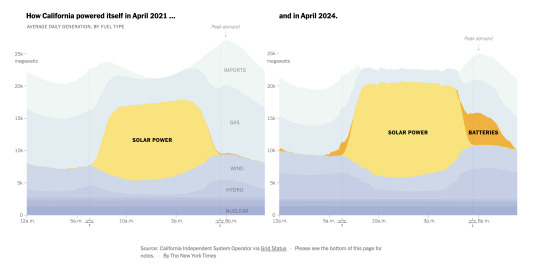
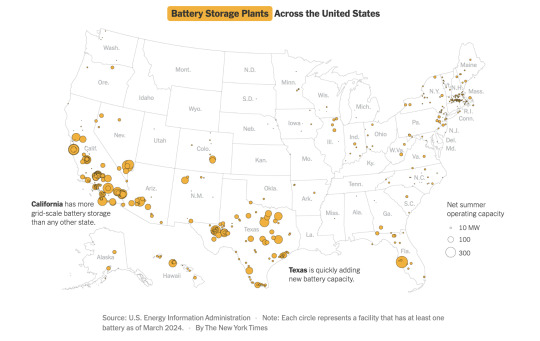
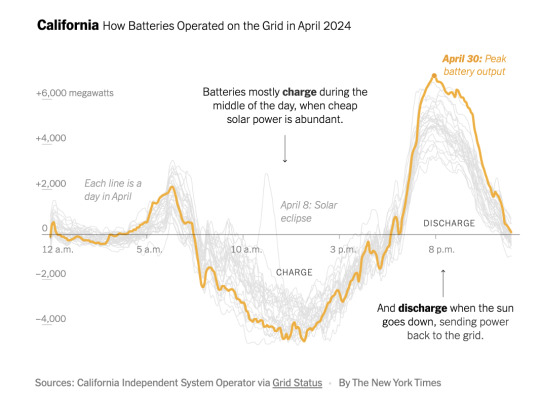
Excerpt from this New York Times story:
California draws more electricity from the sun than any other state. It also has a timing problem: Solar power is plentiful during the day but disappears by evening, just as people get home from work and electricity demand spikes. To fill the gap, power companies typically burn more fossil fuels like natural gas.
That’s now changing. Since 2020, California has installed more giant batteries than anywhere in the world apart from China. They can soak up excess solar power during the day and store it for use when it gets dark.
Those batteries play a pivotal role in California’s electric grid, partially replacing fossil fuels in the evening. Between 7 p.m. and 10 p.m. on April 30, for example, batteries supplied more than one-fifth of California’s electricity and, for a few minutes, pumped out 7,046 megawatts of electricity, akin to the output from seven large nuclear reactors.
Across the country, power companies are increasingly using giant batteries the size of shipping containers to address renewable energy’s biggest weakness: the fact that the wind and sun aren’t always available.
“What’s happening in California is a glimpse of what could happen to other grids in the future,” said Helen Kou, head of U.S. power analysis at BloombergNEF, a research firm. “Batteries are quickly moving from these niche applications to shifting large amounts of renewable energy toward peak demand periods.”
Over the past three years, battery storage capacity on the nation’s grids has grown tenfold, to 16,000 megawatts. This year, it is expected to nearly double again, with the biggest growth in Texas, California and Arizona.
Most grid batteries use lithium-ion technology, similar to batteries in smartphones or electric cars. As the electric vehicle industry has expanded over the past decade, battery costs have fallen by 80 percent, making them competitive for large-scale power storage. Government mandates and subsidies have also spurred growth.
As batteries have proliferated, power companies are using them in novel ways, such as handling big swings in electricity generation from solar and wind farms, reducing congestion on transmission lines and helping to prevent blackouts during scorching heat waves.
In California, which has set ambitious goals for fighting climate change, policymakers hope grid batteries can help the state get 100 percent of its electricity from carbon-free sources by 2045. While the state remains heavily dependent on natural gas, a significant contributor to global warming, batteries are starting to eat into the market for fossil fuels. State regulators plan to nearly triple battery capacity by 2035.
2 notes
·
View notes